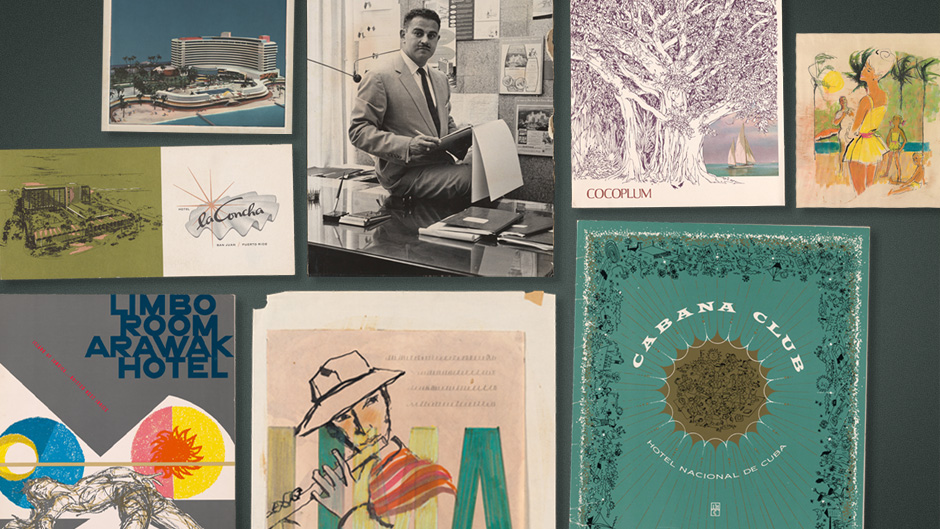It is a throwback to a different era.
Elegant couples wearing tailored clothes while lounging in the lobby of the Fontainebleau Hotel in Miami Beach.
Menus from the Hotel Nacional in Havana advertising their enticing, mouthwatering offerings.
A lithe limbo dancer braves a low-lying pole while advertising the Limbo Room at the Arawak Hotel in Jamaica.
These are part of the trove of advertising gems created by Erwin G. Harris and his design agency during the 1950s and early 1960s. The Erwin G. Harris Archive of Advertising and Commercial Art has now been donated to the University of Miami Libraries Special Collections.
An advertising executive based in Miami, Florida, Harris was born in Yonkers, New York, in 1921. He moved to Miami after serving in World War II and founded Harris & Company Advertising Inc. in 1952.
The collection includes prints, transparencies, sketches, mock-ups, and maquettes, as well as promotional materials created by Harris and his advertising firm. It features advertising materials that promoted businesses and organizations in Miami and throughout Florida and other parts of the United States, as well as several Caribbean countries, including Cuba.
“It is a slice of Miami and Caribbean life,” said Cristina Favretto, head of Special Collections. “A window into the world we came to know through ‘Mad Men’ [referring to the popular television series]. It’s also a rich and fascinating testament to a person who was very talented and very committed.”
The collection also includes correspondence to and from Harris, photographs, advertising campaign proposals, and other documents pertaining to Harris’ businesses, along with legal documents.
“His work was and is influential because it embodied a very ‘Miami’ aesthetic,” said Favretto. “There’s a real glamour to his designs, and the promise of that glamour brought tourists to South Florida.”
Harris’ grandson Matthew Abess, a writer and former curator at The Wolfsonian–FIU, noted his family’s long relationship with the University—the Abess family has supported the University of Miami over four generations, most recently with their funding of the Abess Center for Ecosystem Science and Policy, as well their placement of the Erwin G. Harris archive with the Department of Special Collections.
“There was never any question that this archive should reside with Special Collections,” said Abess. “The holdings there are among the finest in the world, and the staff the most professional. We have always admired the work of students and researchers that draw on the library’s resources, and we are eager to see how scholarship informed by these materials can be used to further enrich our community—especially given the direct role much of the content played in the development of South Florida and our relationships with Latin America and the Caribbean.”
Many notable businesses became Harris’ clients. These included the Fontainebleau Hotel, the Eden Roc Hotel, Intercontinental Hotels, the Havana Riviera, Cutty Sark, the American Society of Travel Agents, Lillie Rubin, Jordan Marsh, and Bal Harbor Shops.
Cuba was one of Harris’ clients, and Harris traveled to the island often. That continued until after the revolution triumphed in 1959 and Cuba stopped paying for a campaign Harris had created for the Instituto Nacional de la Industria Turística (INIT).
Harris took Cuba to court and obtained U.S. court documents to seize goods from the Cuban government after he had been left unpaid for the INIT advertising campaign, said Abess.
Among the goods seized were two Cubana Airlines passenger planes, five cargo planes, a Cuban Navy vessel, a boatload of Cuban cigars, 1 million pounds of insecticide, and 3.5 million pounds of cooking lard.
Harris’ legal dispute with the Fidel Castro regime gained him a lot of publicity and support, and many of the letters and articles documenting the dispute are part of the collection, Abess said. Eventually, Harris was obligated to return many of the Cuban assets, and he filed for bankruptcy. He was able to rebuild his business, but not on the same scale, said Abess.
Abess believes the collection will be beneficial to students and scholars from many disciplines.
“The collection is perfectly suited to interdisciplinary scholarship, which is a core principle of contemporary higher education,” he said. “There are the obvious resonances with communication and advertising, architecture and design, travel and leisure, postwar economics and Cold War geopolitics; and then there are other frontiers that we haven’t yet considered, but that students and faculty will surely map and share with the wider world.”
This archival collection has been digitized in full. For more information about the materials and how to access them in person, consult the Erwin G. Harris Archive of Advertising and Commercial Art finding aid.

